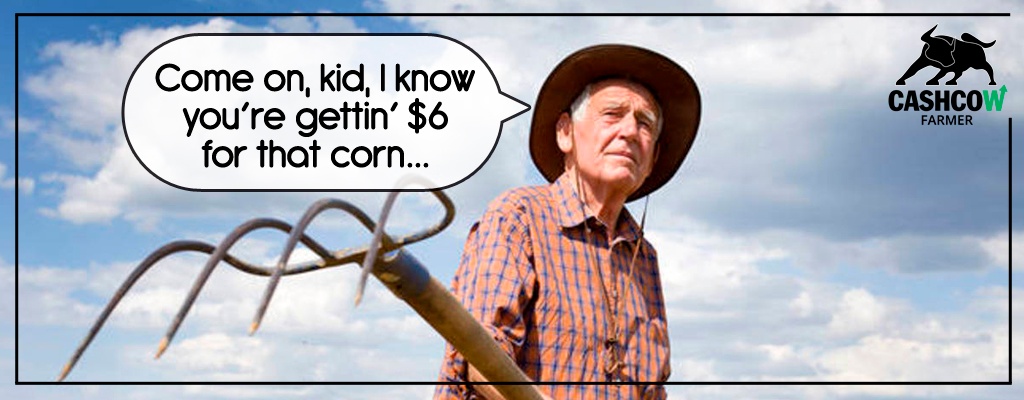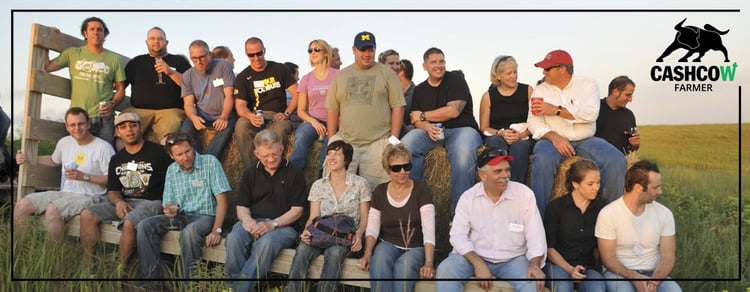Don't have time to read, click play above or subscribe to our podcast on itunes.
There are two main strategies farmers use to grow their operation. One is buying farmland; the other is renting it.
I’ve talked to numerous farmers who sign up for Cash Cow who are concerned with their cash rents. They don’t want to lose their operation because the cash rent’s too high and they’re not making money. That is, they don’t want the ship they’ve chosen to ride to sink in the middle of the sea.
If you can relate to that feeling, take it easy. These four steps will help you manage your cash rent and set you up to improve profitability.
1) Determine the Commodity Prices by Using the Past 3 FSA Marketing Year Averages
Step one is to find the right price to measure your marketing year success against.
Every year, the FSA puts out marketing year average prices. Their reports make for an excellent history you can take advantage of.
Take the last three years’ prices on the report and average them. For example, the projected futures price for 2015 corn was $3.70. In ‘13-’14, it was $4.46. And in ‘12-’13, it was $6.89.
That big six-dollar price will bring up the average, but it has to be taken into consideration. (Some of the landlords still think we get $6 for our corn!)

2) Find Your Production Costs per Bushel
Finding your production costs is the most time-consuming part because you’ll want to do it on every field.
Calculate using the following formula:
1) Find your farm operating costs per acre - These are your annual expenses for labor, machinery, land expenses, living expenses, etc. Factor in any expenses at all, even admin costs and the insurance on your trucks. Add all these costs for the year and divide them over all your acres.
2) Add input costs per acre for seed, fertilizer, chemical, insurance, rent, and any custom expenses - Do this for each field; they’ll all be different. (My insurance fluctuates dramatically within the same county.) Note: it’s important to know exact prices.
Add those two totals together and you’ll have the cost per acre.
Then:
3) Deduct revenues such as government programs and insurance revenues - If you’re getting an ARC-CO payment or using an NRCS program or getting any other government revenue, you need to deduct it from your input costs on those fields. You might not get government revenue on all your fields, but any deduction helps. Same goes for insurance revenues.
Now you have your cost per acre to produce that bushel of corn, soybeans, etc.
Then:
4) Add up all costs per acre and divide by the yield to get your costs per bushel - Let’s say it costs $500/acre to produce corn and you’ve got 200 bushels of corn. Take 500 divided by 200: your cost to produce a bushel is $2.50. (Your cost per acre is likely more than $500, that’s just an easy math example.)
If your final cost of production is below the three-year marketing average you found, you’re in a good financial position.
3) Ask Yourself What You Can Do to Improve Your Operation???

Farming’s a competitive marketplace: there are good and bad farmers, and everyone knows who they are. Whichever category you fall into, there are many things you can do to improve your profitability and lower your costs.
For example, take advantage of precision technology to avoid being left in the dust. Sectional shutoffs and GPS are today’s farming miracles.
Labor management, equipment costs... all these have to be properly managed. If others are doing this, they’re going to be able to farm that rental ground for less than you and eventually pick it up. That’s the beauty (and anxiety) of competition.
Check local benchmarks on university websites to see how your costs stack up to your competitors’ (universities have lots of data on average costs). Or find a consultant in your area that can help you. (We do consulting here at Cash Cow, as well.)
Don’t neglect talking to retired farmers, either. Use whatever means possible to improve your operation.
4) If You’re Still Losing Money, Talk to the Landlord and Negotiate...
...but don’t bet on a landlord’s taking a pay cut in rent. If they do, great. If not, help them find another tenant.
Meet with the landlord, and show them the data that explains how you’re taking a loss by continuing to rent. Point them to neighbor farmers. Say, “You can call so and so to see if they’ll rent it for what you want. If not, my offer still stands to come down by [10%, 12%, or whatever you choose].”
The opportunity to farm that ground again may come down the road, so you never want to burn a bridge. Treat your landlord with respect, but don’t continue to rent land that’s costing you.
Bottom Line: Do the Work and Exhaust Your Resources
It’s hard work figuring up your cost of production and other costs, but that work will pay off in many ways.
And you don’t have to do it all alone. There are great resources out there to help you price cash rent. Take a look at some:
The Art of Negotiating Farm Land Rent (blog post)
Getting More by Stuart Diamond (book on negotiating)
Cash Cow Farmer (software to make accounting easy; consulting to make failure hard)
As seen on Farm Futures
Cash Cow Farmer was created to keep you from leaving a single dollar of profit on the table. Give it a look to learn more about how Cash Cow optimizes your operation!
To learn more about the Cash Cow Farmer program, including software and consulting, give us a ring!




